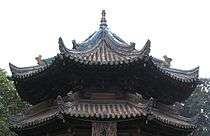Wang Daiyu
Wáng Dàiyú (simplified Chinese: 王袋舆; traditional Chinese: 王袋輿; pinyin: Wáng Dàiyú; Wade–Giles: Wang Tai-yü, Xiao'erjing: ٔوْا دَﻰْ ﻳُﻮْ) (ca. 1570 - ca. 1660) was a Chinese Muslim (Hui) scholar. His given name was Ya, style name Daiyu. He called himself Zhenhui Laoren 真回老人 ("The True Old Man of Islam") and went by his style name.
| Part of a series on:
Islam in China | ||||||
|---|---|---|---|---|---|---|
 | ||||||
|
||||||
|
| ||||||
Life
His earliest ancestor in the early Ming period came to China in the retinue of a Tributary Emissary from the West (the Arabian peninsula). Because he was adept at the art of astronomy and calculating calendars, he held the office of Master Supervisor of the Imperial Observatory, and was granted a residence in Lu Fei Lane (present day South Hong Wu Street) in Nanjing.[1]
Philosophy
His descendants followed in this field. As a child, Wang Daiyu learned from his father. Later, he studied under Ma Junshi from Nanjing. At the age of 20, he began studying Chinese and an intensive investigation of the writings of Confucianism, Buddhism, Daoism, as well as other miscellaneous teachings. In the fifteenth year of the reign of the Chongzhen Emperor, he made a translation of Zhengjiao Zhenquan (正教真詮, "A True Explanation of the Right Religion"),[2] in twenty "juan", and began the enterprise of translating the Islamic scriptures into Chinese. Later, he also wrote Qingzhen Da Xue (清真大學, "The Great learning of Islam") and Xizhen Zhengda (希真正答, "Rare and True Answers"). Within Chinese Islamic circles, he is known by the laudatory title, "Great Saint of the Qing Period." Wang believed in providing Islamic works in Chinese-language versions instead of depending upon Arabic ones.[3]
Works
Wang was fluent in Chinese, Arabic, and Persian[4] He studied Confucianism extensively and used it to explain Islam.[5][6]
Wang wrote "The Real Commentary", in which he uses Chinese Classical texts to explain Islam, since Chinese speakers couldn't read original Islamic texts in other languages. He is most critical of Buddhism and Taoism, while citing Confucian ideas which agreed with Islam in order to explain it.[7]
Wang wrote about Islam in the Chinese language and in a Confucian context, not to convert non Muslim Chinese to Islam, but to help Muslims in China understand Islam, since the majority of them spoke Chinese at his time.[8]
Wang also used the Chinese language and Confucianism to explain Islam to non Muslim Han Chinese in addition to Muslims.[9]
Wang Daiyu's works eventually became part of the Chinese Islamic text the Han Kitab, along with other Muslim scholars from eastern China like Liu Zhi (scholar), and Ma Zhu.[10]
References
- ↑ Michael Dillon (1999). China's Muslim Hui community: migration, settlement and sects. Richmond: Curzon Press. p. 36. ISBN 0-7007-1026-4. Retrieved 2010-06-28.
- ↑ http://www.sino-platonic.org/complete/spp110_wuzong_emperor.pdf p. 8.
- ↑ Michael Dillon (1999). China's Muslim Hui community: migration, settlement and sects. Richmond: Curzon Press. p. 38. ISBN 0-7007-1026-4. Retrieved 2010-06-28.
- ↑ Tan Ta Sen; Dasheng Chen (2000). Cheng Ho and Islam in Southeast Asia. Institute of Southeast Asian Studies. p. 118. ISBN 981-230-837-7. Retrieved 2010-06-28.
- ↑ Gek Nai Cheng (1997). Osman Bakar, ed. Islam and Confucianism: a civilizational dialogue. Published and distributed for the Centre for Civilizational Dialogue of University of Malaya by University of Malaya Press. p. 75. ISBN 983-100-038-2. Retrieved 2010-06-28.
- ↑ Aliya Ma Lynn (2007). Muslims in China. University Press. p. 27. ISBN 0-88093-861-7. Retrieved 2010-06-28.
- ↑ Sachiko Murata, William C. Chittick, Jāmī, Daiyu Wang, Tai-yü Wang, Chih Liu (2000). Chinese gleams of sufi light: Wang Tai-yü's great learning of the pure and real and Liu Chih's Displaying the concealment of the real realm ; with a new translation of Jāmī's Lawāʼiḥ from the Persian by William C. Chittick. SUNY Press. p. 22. ISBN 0-7914-4637-9. Retrieved 2011-05-21.
- ↑ Sachiko Murata, William C. Chittick, Jāmī, Daiyu Wang, Tai-yü Wang, Chih Liu (2000). Chinese gleams of sufi light: Wang Tai-yü's great learning of the pure and real and Liu Chih's Displaying the concealment of the real realm ; with a new translation of Jāmī's Lawāʼiḥ from the Persian by William C. Chittick. SUNY Press. p. 4. ISBN 0-7914-4637-9. Retrieved 2011-05-21.
- ↑ Lindsay Jones (2005). Lindsay Jones, ed. Encyclopedia of religion, Volume 7 (2, illustrated ed.). Macmillan Reference USA. p. 4632. ISBN 0-02-865740-3. Retrieved 2011-05-21.
- ↑ Gail Hershatter (1996). Remapping China: fissures in historical terrain. Stanford California: Stanford University Press. p. 103. ISBN 0-8047-2509-8. Retrieved 2010-06-28.